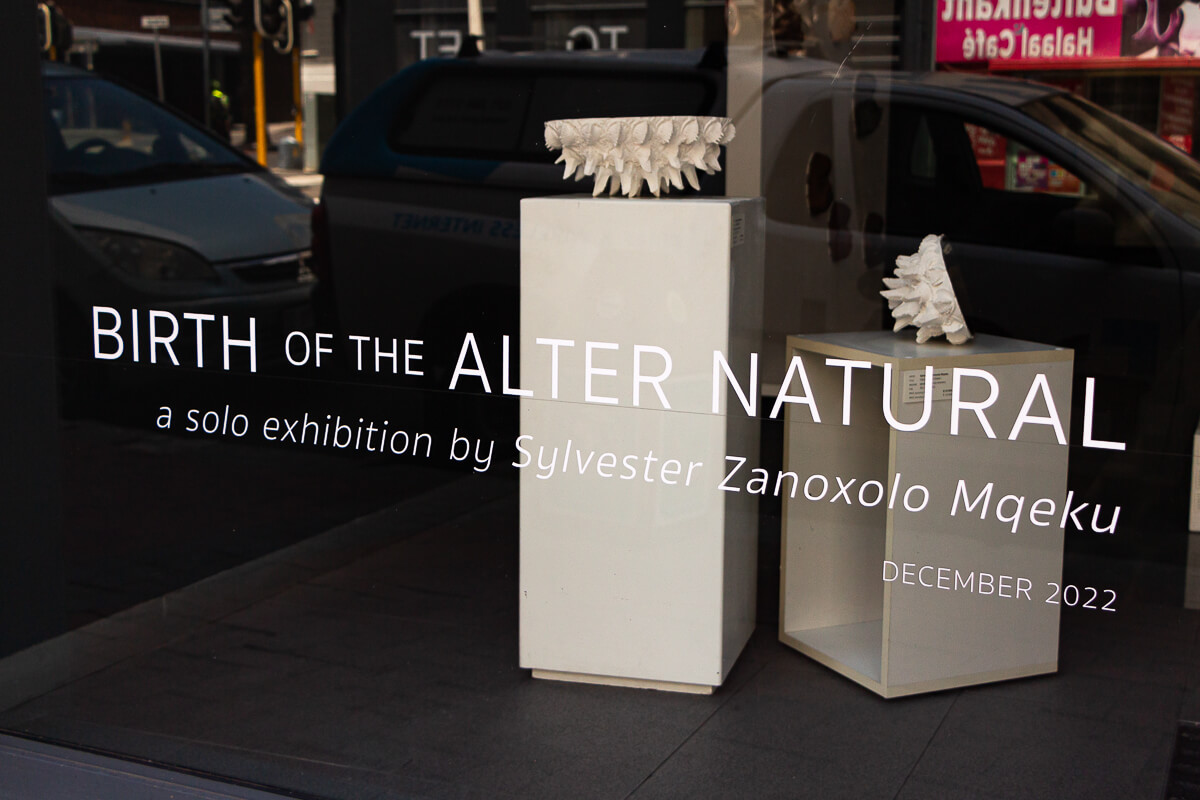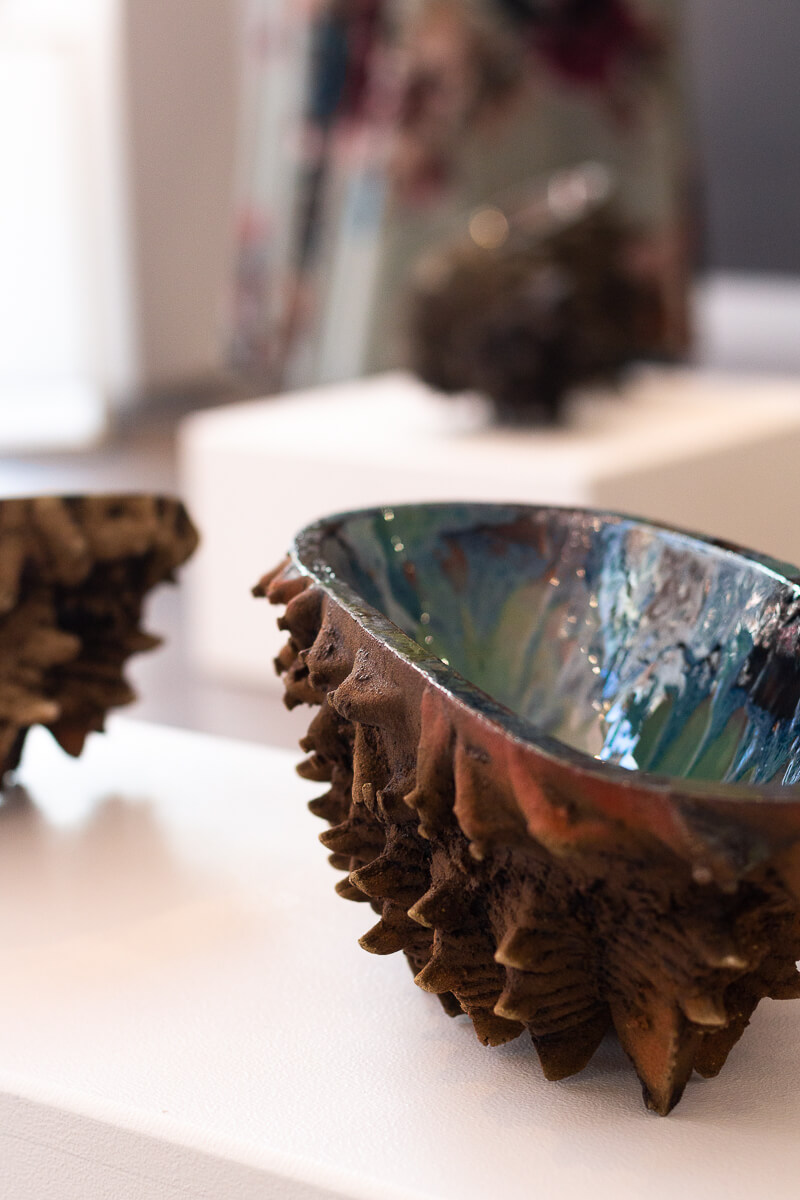On 3 December StateoftheART hosted the opening of Sylvester Zanoxolo Mqeku's debut solo exhibition 'Birth of the Alter Natural'. Mqeku was announced the StateoftheART Gallery Award winner in 2021.
View the 'BIRTH OF THE ALTER NATURAL' exhibition online>
Read Sylvester Zanoxolo Mqeku's opening address below:
Welcome, everyone. I'm so glad you took time in your day to come and see some weird artworks. I'm really honoured to have been the prize winner for the 2021 StateoftheART Gallery Award, I have always seen it from a distance and then I was announced as the winner and I knew trouble was about to start, because now I have to produce real work.
I've been pursuing a Master's Dissertation for the past three years studying the technique of sand cast ceramics. Sand casting is quite common, they use it for metallic alloy component manufacture. It is a very reliable process because sand is a durable medium which can take hot alloys - it can take metal, it can take iron. But nobody's ever tried to cast ceramics in sand.
I use two clays: white clay and red clay, those are the only two clays that perform very well for me. Conceptually speaking, the Birth of the Alter Natural is born out of my discoveries about forms of ceramic art that have been produced for thousands of years across the planet and by different civilizations. Clay is one of the most widely used mediums for making art, for making plates, even for making spacecrafts - because it is super heat resistant if you fashion it properly.

When I was considering work for this solo exhibition, I was quite inspired and awed by the knowledge that clay lasts a long time, especially fired clay. And being located in South Africa, it is important for us to know about previous civilizations. For instance, the oldest human remains were found in Africa: South Africa and Kenya. The oldest abstract artwork ever discovered was found in South Africa - Blombos Cave, about 300 kilometres from here. The oldest fired ceramic we have ever found were discovered in Czechoslovakia in 1973. And it was a little doll, called the Venus of Dolní Vestonice. What makes it so special for me is that it's made of ceramics and it is 28,000 years old. So ceramic artists have something to honour there, because whatever we make now with ceramics, could also last that long - we can't last that long. I used a lot of the information available on the Venus figure when I was writing my dissertation. It offers a lot of details about the kind of people that were alive during the time.
But down the line, you discover that if you find such an old crosshatch inscription on a piece of clay from Blombos cave, what does that say? It says, human cognition and human intelligence began with abstract thinking, or perhaps a large part of it is abstract thinking.

We are living in a time where human intelligence is competing with artificial intelligence. But the problem is that human intelligence has developed from cave paintings and abstract inscriptions on clay to making nuclear bombs. That's how intelligent we are as a human species. But what happens when artificial intelligence is able to learn things faster than us? In 15 years AI could learn what we took 5000 years to learn. So what is artificial intelligence going to do for us? Is it going to carry us forward towards an imminent destruction of ourselves and our planet? The Birth of the Alter Natural speaks to that.
We are losing our connection to nature. Are we nature? Maybe we come from another planet and we've found our way through different times and eras and developed into what we are now.
So what is artificial intelligence doing: we have virtual reality, artificial reality, the metaverse. What are those things and are they an alternative to human consciousness? A cancellation? Are we going to continue to think or imagine - to dream? AI cannot map the algorithm of the soul. We haven't even figured out our consciousness, yet already artificial intelligence is speeding past us. We are also looking for alternatives to our own planet. That's why in this exhibition I am playing with that thinking - asking what is becoming of humanity? I know we're not going to go extinct, because we are already travelling to other planets, yet we can't manage this one.
My belief in the work is based on the knowledge it will outlast me. I'm going to die in a few years time, but my work will remain behind. And I know that up to 30,000 years in the future at least, people will still continue to see it.
If we completely depend our human consciousness and intelligence on artificial intelligence, at some point someone will have one switch to switch off everything. That means the rest of history wiped out in an instant, except if we encode our information in clay.

Sand casting works like this: it's simple, I use damp sand, like playing at the beach and dig inside it. I make all sorts of imprints with whatever tools I can find, or use my own thumbs. I mostly use 3D printed tools I make, hand crafted tools, found objects, bottle caps, sticks, twigs, whatever I feel I can associate with the theme I'm working on. After I dig inside the centre, pour liquid clay slip and just let it dry there for a couple of days. When I pull it out and dust off the sand then I fire it and hope it doesn't crack. Then the glazes come into play. As you can see by the terminology that I'm using in my work - 'Dycloscopic 4022', 'Triassic Pollen', 'Oberon Glaciate', all these names are attached to how I look at the Earth, the planet, and what other planets present to us with our scientific knowledge.
Overall, it's quite a simple process in that sense, but in between digging in the sand, pouring the clay, taking it out, dusting it off, there is control involved: I control the shape - the circle or the oval. I wanted to make ceramics that are different but which can be presented like normal ceramics with pottery - but anybody who calls my work pottery, we will fight, because it's not!
I think I'm also catering for the viewer and how they receive the work. If this is in your house, I want you to see different things every day you look at the sculpture, until you know every detail of the surface. But even I haven't gotten there yet. It creates an opportunity for you to enjoy looking at it and holding it.
We've seen Cuneiform tablets, we've seen the Venus figurines of the Upper Palaeolithic Era. I've seen the most amazing pottery in Cameroon, in Zululand, in Senegal, in Nigeria, practices that span thousands of years. This has lead me to conclude that we essentially live to try be immortal . Because we are not immortal - we live for a while, and then we pass. It's only what we leave behind that makes sense to future civilizations. The oldest artworks, buildings, clothes, leather, handwriting - none of those things can outlast fired ceramics. And with that I'm going to end my talk.
Welcome to the Birth of the Alter Natural.



